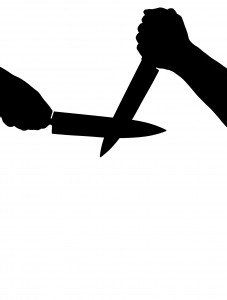Can the knife grip an attacker uses indicate his or her training level?
The short answer is: no. A blade is a blade, and it will spoil anyone’s day quickly, efficiently and lethally. It doesn’t matter in whose hands it finds itself—man or woman (or child), trained or untrained.
First, let’s define terms. There are two basic grips on a knife. In Kali they are called heaven grip and earth grip. Pick up a knife. If, when holding your arm straight to the front, the point of the blade points upward, that is heaven grip. If the knife is gripped so the blade exits the fist from the pinky side and points toward the floor, that is earth grip.
An untrained attacker will most likely hold the knife in heaven grip. It is familiar because it is the most often shown method in movies or described in books. It is comfortable because it closely mimics the way we cut up food. Easy to stab. Easy to slash. Excellent for keeping the attacker at a distance. The key words are “most likely.” In the stress of the moment, in the middle of the hard-hitting action, when survival is on the line, people can and will grab a knife and attack anyway they can.
The pluses of heaven grip are also advantages for a trained or experienced knife-fighter. It is comfortable, easy to kill or maim…and frightening. And riveting. The experienced fighter keeps the blade moving, slashing, stabbing, and feigning. The victim can be distracted by the moving blade. A moving target is harder to hit, harder to block or disarm. The more attacks executed, the more chances of doing harm. This is a living breathing example of: nothing ventured, nothing gained.
If faced with an attacker holding a knife in earth grip, he is most likely trained. Slashing and stabbing in earth grip is not as natural as in heaven grip. The attacker has to be a few inches closer to the victim to slash and stab. But if the hand is held down alongside the thigh, the knife can be hidden until it is needed. This involves thinking ahead. Anyone, trained or untrained, can plot to kill someone with a knife, but a trained person will most likely use this grip to hide the knife until the moment of execution because there is no real defense against a surprise knife attack such as this from a trained knife fighter.
Once again, in the heat of the moment with nothing else to do but fight, an untrained person will grab an available knife and use it. The survival instinct grinds off the ifs, buts and most likely-s. A person fighting for his or her life is capable of anything, which also involves planning ahead.
And don’t forget the blood. Lots of it. Slippery, stinky, scary blood. Here lies the dividing line between the trained and untrained, the experienced and inexperienced. The feel of the cool steel, the warmth of the blood, the horror of being sliced will cause an inexperienced person to pause—the iconic gaze of the victim from the blood on his hand to the face of the attacker. A pause that, in real life, is the second when the experienced knife-fighter administers the “money shot.” The lethal blow. The fight-ender.
An experienced fighter knows that when an altercation becomes physical, it will involve injury, pain and blood. It is part of fighting. Expected. No cause for pause. He or she will fight unceasingly. Until the opponent is unable or unwilling to continue the fight. Whether he or she is the victim or the aggressor, a fighter fights.
I must say at this point, this is a quick blog about knife fighting. There are many holes in my theory, and if you see them, feel free to comment. I’m interested in your point of view.
Reality can be as dramatic as fiction.
Get it right. Keep it real.
Janet McClintock



I’ve been browsing online more than three hours as of late,
yet I never discovered any fascinating article like yours.
It’s lovely price sufficient for me. In my opinion, if all
site owners and bloggers made excellent content material as you did, the internet will
likely be a lot more helpful than ever before.